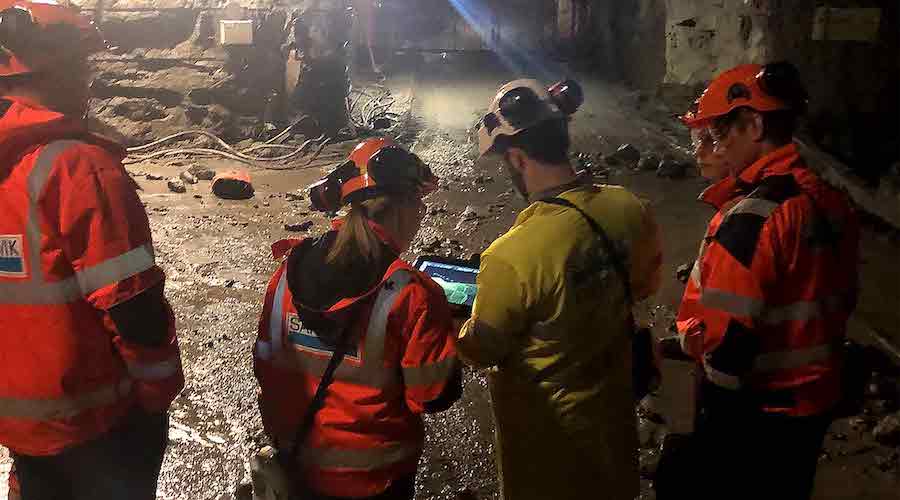|
The future of mine safety;
Less time underground, more autonomous tech/robots
Monday, June 22, 2020 - 2:14:32 PM
Mining
|

|
The conclusion was drawn from a webinar organized by technology company Exyn and where Vale’s Digital Leader, Anthony Downs, EY Canada Mining & Metals Industry Co-Leader, Theo Yameogo, and non-profit organization Norcat’s CEO, Don Duval, discussed the impacts of digital innovation in mine safety.
According to the experts, mining companies are likely to continue investing in the deliberate deployment of technology and mine design to get the worker out of harm’s way. This means putting fewer workers underground and bringing in autonomous systems that have user interfaces that appeal to a younger generation.
“I think we’re going to see a situation where a worker will go from sitting on one piece of equipment to supervising a handful of pieces of equipment all autonomously being tasked to do various things,” Downs said.
The new technology is also expected to capture better quality data which, in turn, should be used to drive better technical and strategic decisions. And these data are not only expected to show safer and more efficient ways to blast or drill but also to assess depression, fatigue, and anything that might inhibit workers’ ability to make sound decisions, particularly those that do need to get put into environments with a high degree of risk.
In the view of the presenters, assessing workers’ conditions should extend to what takes place once they leave the mine site, particularly when it comes to those working late hours. Previous experiences have shown that many of the safety-related injuries and issues, such as car accidents, happen off-site.
Simulators and drones
The panellists brought to the table a recent trend that involves the use of equipment simulators for people that are learning how to operate specific equipment.
“From a safety perspective, what I find fascinating is where they’re going, where they can essentially equip a sensor to gather data of the actual operator on the actual piece of equipment, gathering a series of data points on the operational effectiveness of that worker operating the equipment in an underground environment and then that data is fed back automatically to the simulator to customize a training program dealing with the problem areas that actual worker is dealing with in the field,” EY’s Yameogo said.
For Yameogo, these training mechanisms are likely to improve not only safety but also productivity. “Because underground not every situation will have an infrastructure to support digital. That’s often a problem in older mines. One of the major changes of the underground environment in the future is this ability of self-driven robotics, tools, and items, that do not require the mining company to make extensive changes to their infrastructure to have work.”
But changes, whether big or small, are already taking place either during the mine design phase or afterwards, as many sites have already started operating on WiFi, LTE, and 5G.
“The LTE network has really become the lifeline for us to do a whole range of different things underground, whether it’s enabling that autonomous or semi-autonomous equipment or enabling smart IoT sensors or whether it’s around worker and equipment tracking so that we know where they are if we need to evacuate a part of the mine we know who we need to go and look for,” Vale’s Downs said.
Robots
Not only autonomous equipment is in the present and future of mine safety but according to the speakers, robots are as well.
Citing studies by EY, Deloitte, Hatch and BDO, the speakers said the consensus is that by 2025-2027 robots will replace about 50% of the mineworkers thereby reducing mining accidents by close to 75%.
“We can debate the timeline but I don’t think the mining industry has an innovation problem, they have challenges around adoption. And so the timeline on which we achieve this full integration and transformation of incorporating robots it might not be 2025 or 2027, but make no mistakes there is increasing shareholder pressure on these mining companies inspiring executives to be more creative than ever to invest in and deploy technologies that can enhance productivity and improve safety,” Norcat’s Duval said.
The presenters recognize that implementation of robotics is going to be different based on regional socioeconomic factors, however, they believe most operations will get there eventually.
For them, robots are likely to be used to enhance the human in a way that makes their work easier and safer.
“What if mine rescue had robots that actually are still going underground and the mine rescue team can do their work from the surface? We have achieved the same results, but without the rescue team going into an adverse condition,” Yameogo said.
http://www.miningnewspro.com/en/News/551855/Less time underground, more autonomous tech/robots
|